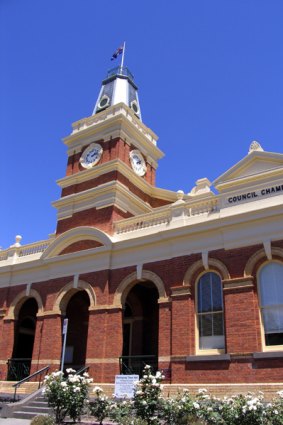
Old style ... the Buninyong town hall.
Buninyong was settled long before Ballarat existed. In 1849 the Geelong Advertiser described Buninyong as the busiest town after Melbourne and Geelong in the Port Phillip District of NSW. By 1851, when gold was discovered in nearby Ballarat, Buninyong already bustled with stores, blacksmith's shops, a medical practice and a boarding school.
A sheep station was established near Buninyong in 1838 and the first buildings in the village, 125 kilometres north-west of Melbourne, were built from 1841, marking the beginnings of one of Victoria's first inland settlements.
Buninyong has history in abundance: the town's first eating house was established in 1841, the Crown Hotel was licensed in 1842, Victoria's first inland doctor, Dr Richard Power, arrived the same year, a post office opened in 1845 and the first clergyman in the district preached at Buninyong in 1847. Blacksmith Thomas Hiscock, who was to play a major role in changing the face of Victoria, arrived in 1849.
When Hiscock found gold at an area still known as Hiscock Gully, three kilometres west of Buninyong, in early August 1851, he ignited a gold rush that was to transform Victoria's landscape forever: a few weeks after Hiscock's discovery, gold was discovered at Poverty Point in Ballarat and the hunt for gold was on in earnest. Over the next decade tens of thousands of gold-hungry prospectors from more than 20 countries poured into Victoria and the state's population swelled from about 77,000 to more than half a million.
Although it's only 13 kilometres from busy Ballarat, Buninyong remains very much its own entity, a charming village that hasn't changed much for decades. There's some splendid colonial architecture that you can discover on a number of easy walks that pass heritage gems like the library (circa 1861), which now houses the local information centre and Bear Hugs, a small shop packed with teddies.
Stroll past original timbered shopfronts to the grand Italianate town hall and courthouse, built in 1866. Equally imposing are the former National Bank (1859), Eagle Store (1858), Uniting Church (1860), old Buninyong Brewery (1855), Anglican Church (1862) and the old Sunday School next door, which dates from 1857.
Buninyong's wide streets and grand buildings were planned with expectations of a booming metropolis, as were the town's lovely botanic gardens, which are among Victoria's oldest.
Plans for the gardens were drawn up in 1859 and many plants were provided by Baron Ferdinand von Meuller (of Melbourne's Royal Botanic Gardens fame).
Today the gardens, which feature a Victorian rotunda, historic sandstone courthouse and pretty lake called the Gong, are a tranquil spot to picnic under the shade of a bevy of beautiful trees, including towering Californian redwoods.
Nearby Mount Buninyong, an extinct volcano, has several walking trails and a lookout tower with great views across Ballarat, Mount Warrenheip, the Grampians and, on a fine day, the sea at Port Phillip Heads.
The landscape around Buninyong features evidence of gold mining at hamlets including Scotsburn, Lal Lal, Magpie, Napoleons and Scotchmans Lead; you can visit a marker at the site where Hiscock struck gold, and see the graves of early pioneers at Buninyong cemetery - the second registered cemetery in Victoria - which makes for a fascinating snapshot of early life on the goldfields.
There are several dining opportunities in town including the Haze Restaurant, the Crown Hotel, the Buninyong Golf Club, Chocalatto (chocolate, ice-cream and coffee), the Old Bluestone Cafe and Gifts - which serves a terrific afternoon tea that includes fresh scones, among other homemade delights - and the Vintage Garden and Cupcake Cafe (sweet and savory pastries, foccacias and cupcakes).
They're big on festivals and events in Buninyong and there's usually something on that makes a visit to the old town even more appealing. The annual Buninyong Film Festival will be on May 1 and 2, and the National Cycling Championships in August.
The Buninyong Farmers' Market, held on the third Saturday of every month, is an opportunity to sample some of the region's produce, including Goldfields Pure Honey, Mount Buninyong Winery, Captain's Creek Organic Produce and Goldfields Farmhouse cheeses.
On of the town's best-loved celebrations is the annual Buninyong Gold King Festival, this year on March 27-29.
The festival has its origins from the generosity of an early Buninyong resident, Henry Desoza, who speculated in both land and mining ventures, struck it rich and donated a share of his wealth to charity. In 1883 Desoza was proclaimed Gold King of Buninyong and today his good works are celebrated with a weekend of music, open gardens, market stalls and old-time favourites like a street parade, billy-cart derby and tug of war.
The Buninyong Heritage Walks booklet ($5) is available at the Buninyong Information Centre and at shops around town. For further information and accommodation options phone the Buninyong Information Centre (5341 8211), or see www.buninyong.vic.au.
Sign up for the Traveller Deals newsletter
Get exclusive travel deals delivered straight to your inbox. Sign up now.